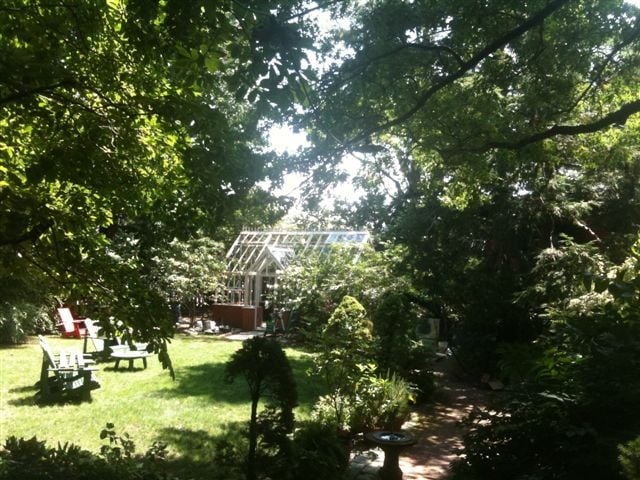
The golden age of greenhouses could easily be said to have been before World War One when huge greenhouses dominated gentrified England. The carnage of WWI ended this golden age when so many men were killed that after the war there were not enough people to run the vast glass and cast iron emporiums. Many of these structures fell into disuse or were dismantled and greenhouses were not seriously considered again until after WWII, some forty years later.
Prior to WWI and II, greenhouses were usually made of cast iron and required large crews of men to erect them in a process that could often take as long as six months. The between war period saw little improvement in greenhouse design and building until Vincent Hartley came along in 1938. He patented a clean uncluttered aluminum framed greenhouse, one that laid the standard for professional greenhouses for years to come. His greenhouses did away with overlapping panes of glass that trapped moss and mildew between the panes and require frequent cleaning. Instead each glass pane was set in its own frame and firmly fixed in place.
Today, the second golden age of the greenhouse has come upon us, and a look in almost any British gardening magazine shows advertisements for many hundreds of greenhouses, but one always stands out, that of the Hartley Botanic Greenhouses. The modern version of Vincent Hartley’s aluminum framed structures graces many of the gardens of the wealthy. Many of these greenhouses have been handed down from father to son or from grandfather to grandson. They have been dismantled, moved and re-erected, yet their quality is so good that some 1950s greenhouses are still use today.
Today Hartley Botanic greenhouses are shipped to many countries and there are an increasing number in America. One of these greenhouses is now part of Eugene Lee’s garden in Providence, RI. Mr. Lee is a designer and for him the greenhouse had to look right and to complement his Victorian style house. “I care what things look like and the Hartley greenhouse looked right as a structure. I looked at the Roger Williams Park greenhouses and they looked how a greenhouse should look. Now that it see my greenhouse in the yard, it complements the yard perfectly,” he said in a recent telephone conversation. “When we decided on the location, we dug the foundation by hand so that we wouldn’t disturb any of the plants in the surrounding area. We dug down below the frost line and put in a foundation that you could build a house on.”
In listening to Mr. Lee, it is obvious that he has plans for the greenhouse. “We have a separate hot water furnace with fin tube heat pipes going around the floor to keep the greenhouse at around fifty degrees and while it has a few herbs and lemon trees in it now, my wife and I plan on filling it quickly.” The greenhouse gets good sun in the mornings and Mr. Lee hopes that it will require the trimming of any of the trees on the surrounding property.
Hartley greenhouses are imported from England where they are made. The company, which has had a distributor in America since the mid 90s but has only had an office here since 2008, does not stock greenhouses in America, instead it builds the greenhouse to the customer specifications. Thus delivery can take a few months. Shelley Newman of Hartley Botanic in Boston said that if everything goes together the greenhouse can be delivered to the customer in 90 days, but if the shipping process, for example, a container might sit on the dockside for a suitable ship, it might take up to five months to get a greenhouse. In general, Ms. Newman says it can take between three to five months from signing the contract to delivery.
During that time the owner will need to install a foundation. Hartley only installs the greenhouse using their factory trained team, they do not provide the foundation, plumbing or electrical lines. In another interesting twist, Ms. Newman says that Hartley does not believe that double pane glass is effective on a greenhouse and all their greenhouses are delivered, as they are in Britain, with single pane glass. However, the company does offer colored or other glass options.
If you want to own a Hartley greenhouse, they are not inexpensive. For example, a Victorian Classic (8 1/2′ x 13′) costs $28,282 plus delivery to your site, plus the costs of erecting it on site. A rough guide to delivery is about $1000 to the northeast and up to $5000 to California. So if you could be looking at about $40000 for a greenhouse if you lived in California. But after all if you want your plants to be the best, you buy the best greenhouse you can afford.
Roger Marshall, Editor – Hobby Greenhouse magazine

